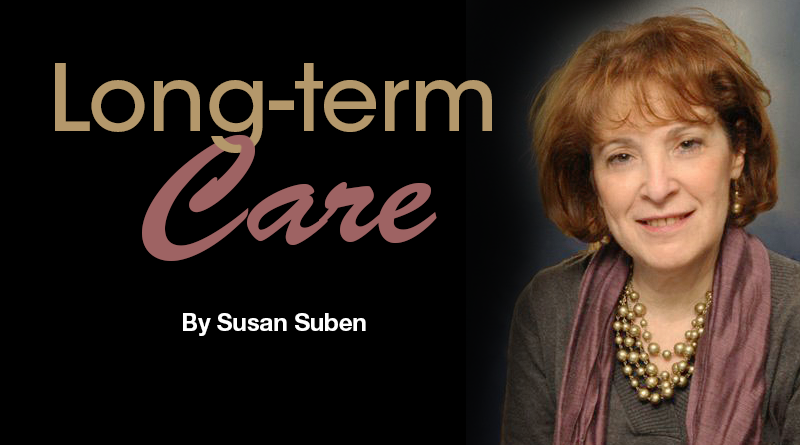LTC: Medicare Vs. Medicaid
By Susan Suben
 If you’re turning 65, it’s important to understand what the difference is between Medicare and Medicaid. Both are government programs but the coverage you can expect from them differs greatly when it comes to long-term care (TLC).
If you’re turning 65, it’s important to understand what the difference is between Medicare and Medicaid. Both are government programs but the coverage you can expect from them differs greatly when it comes to long-term care (TLC).
Medicare is a federal health insurance program for individuals age 65 or older or those with a qualifying disability at any age. To be eligible, you must be a U.S. citizen or legal resident. It is funded by your taxes.
Medicare has many moving parts — A, B, C and D. Part A is hospital insurance, B is medical insurance, C is Medicare Advantage and D is prescription drug coverage.
Let’s look at Part A as it pertains to LTC planning and compare it to Medicaid LTC coverage and requirements.
Part A covers hospital stays and inpatient care. It pays for room and board, care in special units, drugs and medical supplies, lab tests, medical equipment, operating and recovery rooms, blood transfusions, rehabilitation and hospice care. There is no premium payment for Part A if you have worked and paid taxes for 10 years or longer. Coverage is nationwide.
In order to take advantage of your benefits for rehabilitation in a nursing home, you must be admitted to a hospital as an “inpatient” for three days, not on “observation status.” This is a very important distinction for the purposes of LTC. If you are in a hospital under “observation status” and need to go to a nursing home for rehab or permanent LTC, Medicare will not pay.
If you meet the three-day inpatient qualifications, Medicare will only pay for skilled rehabilitation up to 20 days. It will not pay for custodial care, known as activities of daily living (dressing, bathing, toileting, etc.). For days 21 to 100, Medicare will pay for your care except for the 2019 co-pay of $170.50. After 100 days, Medicare pays for nothing. Coverage will last until it’s determined you are no longer making medical progress. On average, individuals receive Medicare reimbursable rehab for two weeks. If you have to enter a nursing home permanently, the same three-day eligibility and 100-day reimbursement rules apply.
Part A also covers part-time, skilled care for someone who is homebound after a qualified three-day inpatient stay. However, once it is determined that you have reached your full potential, Medicare will no longer pay.
Medicare does not pay for assisted living or adult day care.
Medicaid is a federal/state health insurance program for low income individuals. There are strict asset and income requirements that determine eligibility. Medicaid provides nursing home care, assisted living and home care. In addition to the financial requirements, penalties can be imposed if you transfer assets within five years of the date you apply for Medicaid. In comparison, Medicare does not have any financial restrictions.
If your assets and income are above Medicaid limits, you will be required to spend-down your life savings to the required thresholds for the cost of care. Many individuals impoverish themselves to be eligible for Medicaid as a result of not planning for LTC.
The NYS Medicaid resource limit for a single person in a nursing home for 2019 is $15,450. Assets that are at risk for a spend-down include investments, CDs, rental properties/additional real estate, and cash in life insurance policies. Medicaid can even place a lien on your home.
You are entitled to keep $50 per month as income. If you are receiving home care, you will be able to retain $879 monthly income according to 2019 figures.
For married couples with one spouse in a nursing home, the accumulated assets of both spouses are available to the spouse applying for Medicaid. The disabled spouse is entitled to the same income and resource levels as a single person.
The well spouse can retain assets of $74,820 up to a maximum of $126,420 and at least $3,160.50 per month of the couple’s combined income. If the well spouse has his/her own income and it is above $3,160.50, then Medicaid can request a contribution of 25% above that amount.
Home care coverage under Medicaid requires the enrollment in a managed care plan or a Medicaid Advance Plus plan. In some instances, you may not be able to see your own doctor, only those in the plan’s network. Custodial and skilled care, in addition to household services, would be covered.
When it comes to LTC planning, the key difference between Medicare and Medicaid is that Medicare provides limited, skilled care while Medicaid provides skilled and custodial care but requires the adherence to rigid financial guidelines. Awareness of the need for early, comprehensive LTC planning will help you fill in Medicare gaps and help you avoid the loss of your retirement savings for Medicaid eligibility.
Susan Suben, MS, CSA, is president of Long Term Care Associates, Inc. and Elder Care Planning. She is a consultant for Canandaigua National Bank & Trust Company. She can be reached at 800-422-2655 or by email at susansuben@31greenbush.com.

